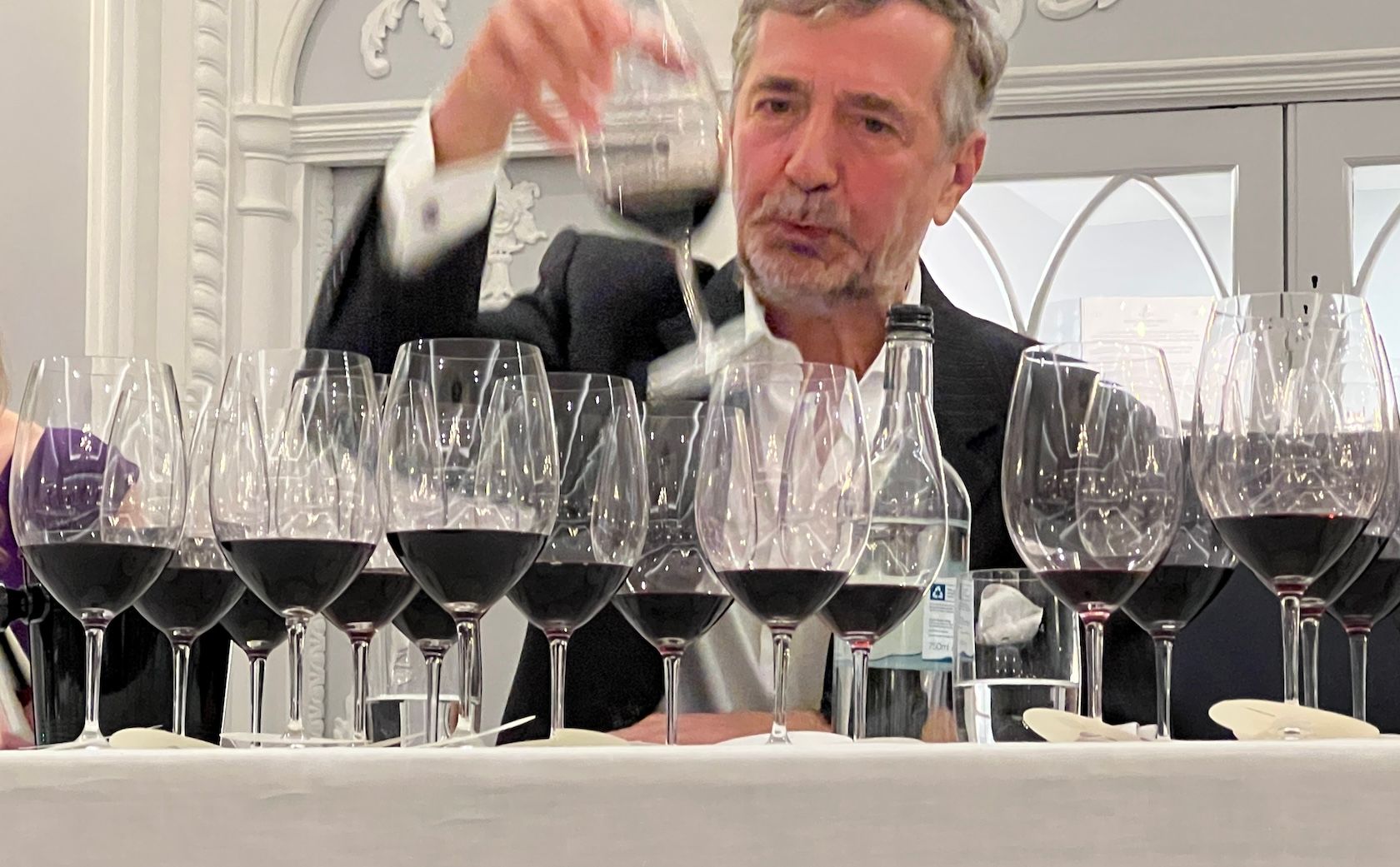Peter Richards MW looked like he had just seen a ghost.
He was co-chairing major London tasting 'Five Decades with Eduardo Chadwick & Family' at London’s Dorchester Hotel when Eduardo confused him with being Stephen Spurrier.
Richards jumped, his arm knocking a fair measure of vintage Viñedo Chadwick over his laptop and looked visibly shaken – and not just because he had possibly kissed goodbye to a grands-worth of laptop and a glass of wine worth a quarter of that.
Perhaps the confusion arose because, in a quaint touch, Richards had worn matching-tie-and-handkerchief in an homage to the always dapper Spurrier. Whatever the case, the influential wine critic was definitely ‘in the room’, after all this, was a wine event set up to mark 20 years since Spurrier had helped the wines of Viñedo Chadwick, Seña and Don Maximiano put themselves on the world wine map with the ‘Judgment of Berlin’.

Before the spillage: Amanda Barnes, Eduardo Chadwick, Peter Richards MW; Five Decades with Eduardo Chadwick & Family tasting, London
Judgments past
Let’s start at the beginning.
Much of Chadwick’s presentation – a colossal eye-opening re-assessment of most of his major wines – had been about the quality of Chile’s terroir and how the best wines can quite happily stand on a podium next to First Growths and Super Tuscans.
Twenty years ago, before 'Berlin', there was more of a point to prove. Chile was in the middle of a rapid wine explosion with production growing from 400 million litres made per annum to one billion litres in the space of a decade (1989-2009). The world couldn’t get enough of Chile’s ripe, fruit-forward style and value for money. In that same time frame exports grew from 7% to 70%.
Eduardo’s mission to earn Chile the same respect that had been afforded to fellow New World regions such as Argentina and New Zealand was one born of frustration and it was (in the words of Hatch Mansfield CEO Patrick McGrath) “his perseverance, bloody mindedness and drive to succeed that has been so responsible for changing the world’s perception of wine in Chile.”
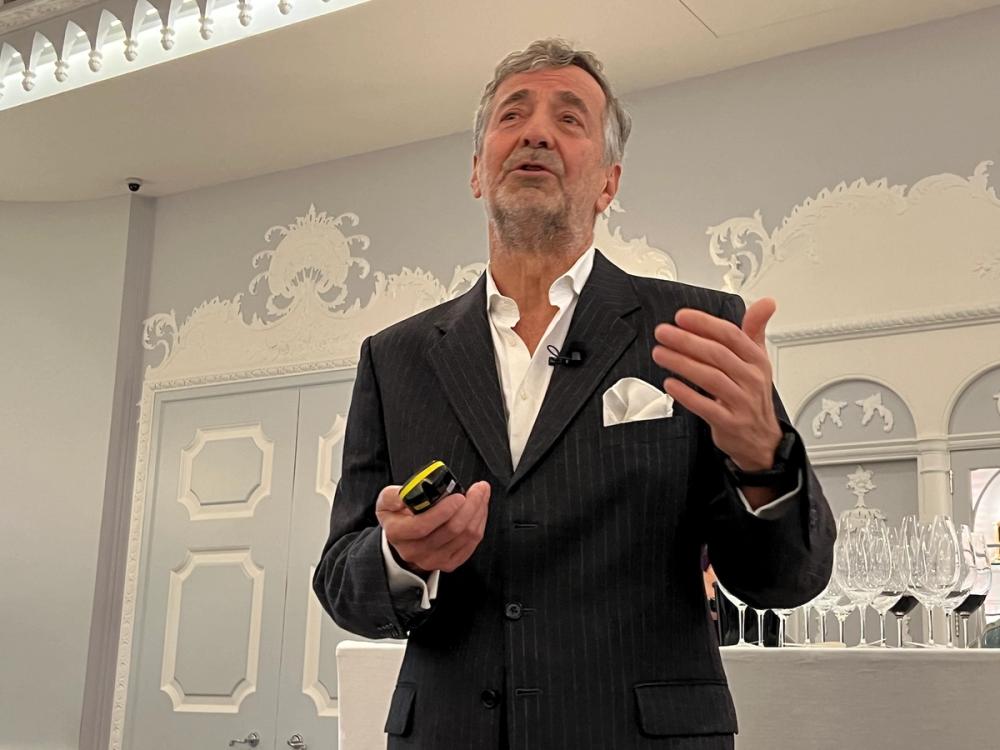
Eduardo Chadwick: “Our first challenge was to learn about the fine wines of the world"
Having tried all the traditional ways of educating the wine trade about the quality of its wines, Eduardo sought a landmark event that would draw a line in the sand and drew inspiration from 1976’s 'Judgment of Paris' in which Stephen Spurrier had successfully proven that Californian wines could happily rub shoulders with the very best from Bordeaux.
On January 23, 2004 at the Ritz-Carlton in Berlin, Spurrier and fellow critic René Gabriel invited 36 of Europe’s most knowledgeable tasters to evaluate 16 wines from Bordeaux’s millennium vintage and Super Tuscans, many of which had been awarded 100 points by Parker.
The results were as significant as they were eye-opening.
1 Viñedo Chadwick 2000
2 Seña 2001
3 Château Lafite-Rothschild 2000
4 Château Margaux 2001
4 Seña 2000
Viñedo Chadwick 2000 was then tied sixth with 2000 vintages of Margaux and Latour, and Don Maximiano Founder’s Reserve 2001 scored higher than Latour 2001 and Solaia 2000.
This watershed tasting was as key to the world perception of Chilean wine as ‘Paris’ had been in the mid-70s and further marked the democratisation of the wine world. Writing about ‘Berlin’ in the Financial Times, Jancis Robinson MW titled the piece ‘Chilean wine grows up’.
For Spurrier it was the consistency shown during the 21 tasting events that followed that was most significant with Chilean wines placed amongst the top three places in 20 out of 22 events.
“It is this consistency across different vintages over a 10-year period that is so important,” he said.
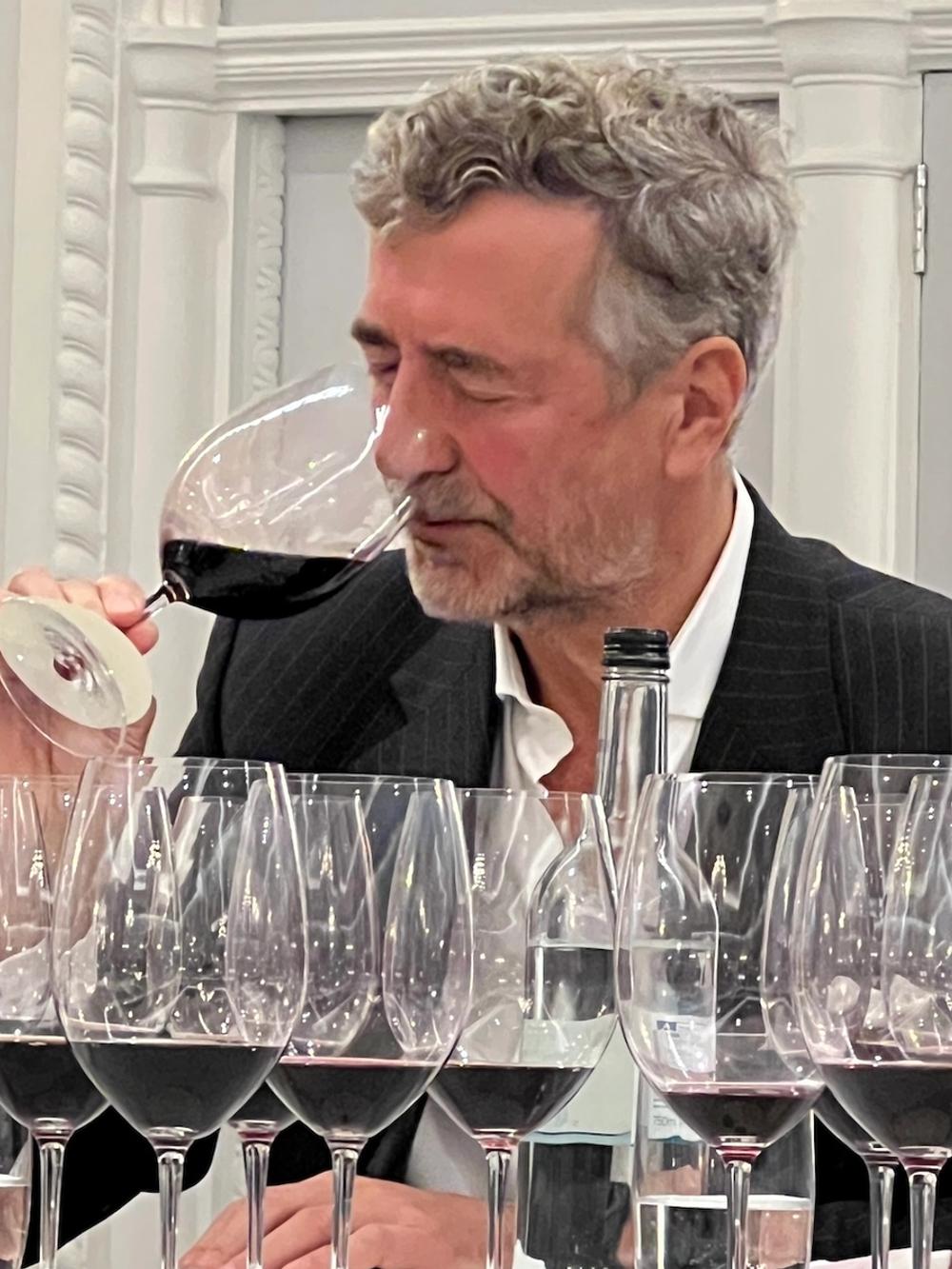
Lost in thought: Eduardo Chadwick
Judgments present
For the 'Five Decades with Eduardo Chadwick & Family' tasting we sat in awe rather than judgment.
Eduardo’s point has already been successfully made and proved to the 1,400 wine critics who attended the 22 Spurrier-chaired events. No, the Dorchester event was an occasion to taste the new vintages of his four premium wines – Don Maximiano, KAI, Seña and Viñedo Chadwick – alongside some beautifully aged library stock and pay tribute to Eduardo’s predecessors who never needed any convincing about the potential of Chile’s terroir.
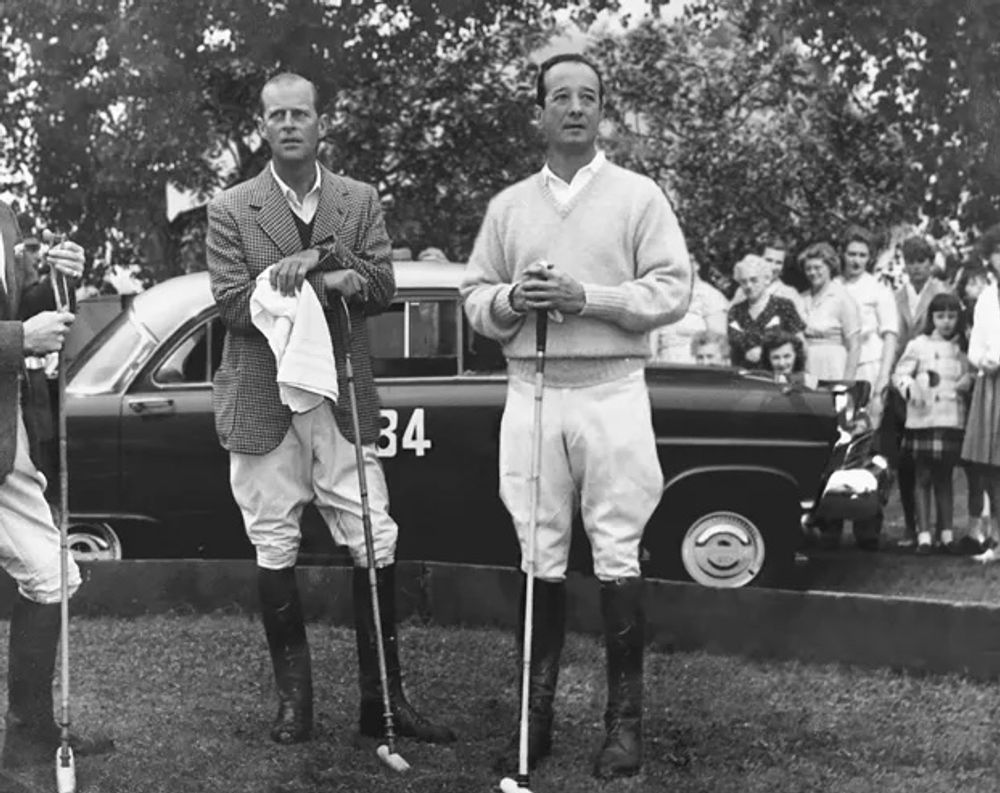
HRH the Duke of Edinburgh and Alfonso Chadwick before a polo match, 1968
We remembered Eduardo’s father Alfonso Chadwick who took the reins of Viña Errázuriz in the 1980s having bought the estate back from the banks in 1983 and returned it to its former glory and we went right back to ‘Don’ Maximiano Errázuriz who returned from Europe in the mid-Nineteenth Century to set up the original winery in the Aconcagua Valley, convinced quite rightly that it had the potential to make spectacular wine.
The Don’s search for ideal terroir was mirrored by the same quest undertaken by Eduardo Chadwick and his original Seña winemaker Tim Mondavi to find more locations to expand into.
Remembering those early days Chadwick said: “Our first challenge was to learn about the fine wines of the world – taking Émile Peynaud, the father of modern oenology, as a benchmark of style. We saw the huge gap and the challenge we had – so we started planting more vineyards and building a team.”
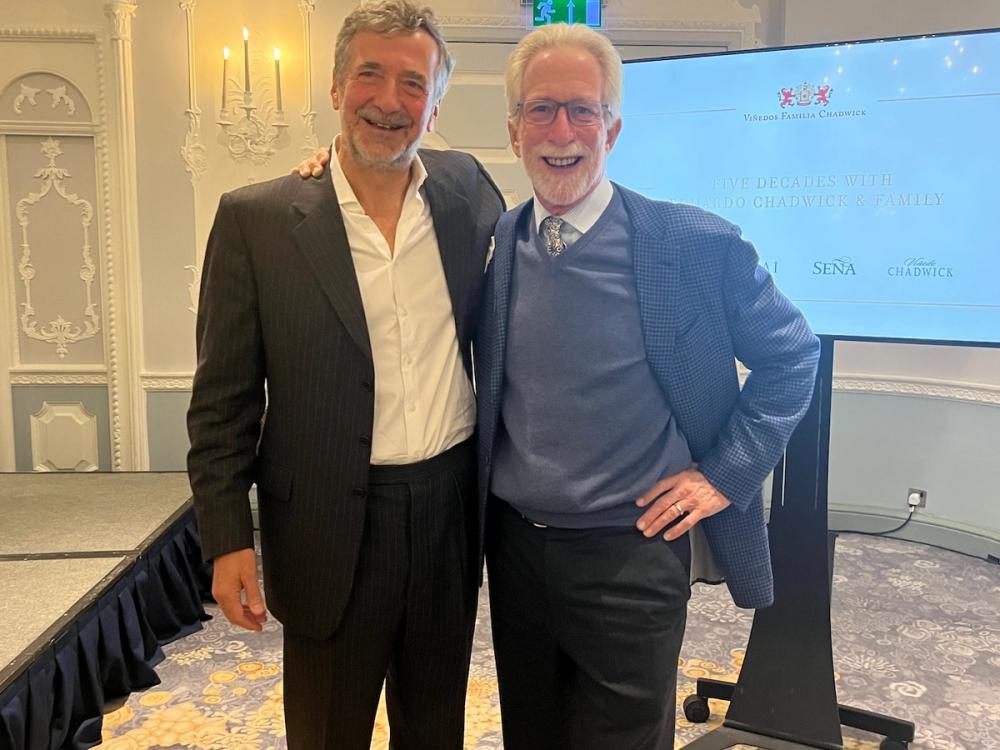
Fancy seeing you here! Eduardo Chadwick and Tim Mondavi
In a bizarre coincidence Mondavi – yes, he the son of Robert – was found just before the event started to be in London, just around the corner, and was called in to make an unscheduled appearance. The pre-prepared slides that showed a young Eduardo with a young Mondavi, some 30 years ago, open map in hand during their four-year quest to find the top sites to plant vines were therefore given an added frisson and ratcheted up an already special event into an unmissable one.
Mondavi ‘s presence provided the missing link – if you like – between the Judgment of Paris that helped propel his father’s wines in the eyes of the world and the various Judgments that has done the same for Eduardo’s.
Mondavi remarked throughout the tasting about how the finesse of the wines, particularly with regard to the tannins, had improved with age. He also made an interesting point how the Pacific Ocean is a game-changer for both Chile and California in the light of climate change.
Now that Eduardo Chadwick has successfully earned his place on the global wine podium who knows what wine judgments we might see in the future whereby the wines of new wine regions try and challenge critics to see them as being equal to the wines of Chile… The Judgment of Oslo anyone? Mumbai? Essex? Watch this space.
The wines tasted
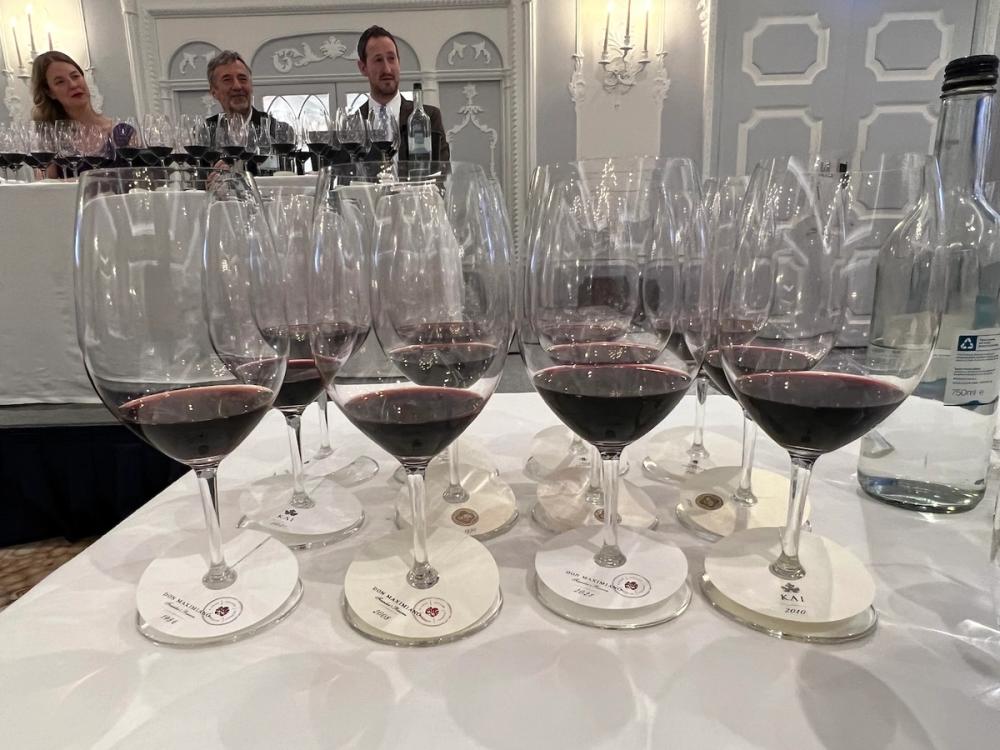
Let the tasting begin
Don Maximiano Founder’s Reserve 1984, D.O. Aconcagua Valley
Viña Errazuriz’s flagship wine – a Cabernet Sauvignon-driven blend – is here seen in its original form, a 100% Cab Sauv with fruit sourced from 10 hectares around the winery, the wine aged for five to seven months in Rauli vats. Nowadays fruit comes from three very different vineyard sites, totaling 90 hectares, the wine seeing more new French oak for a longer period of time.
Deep blood red this is beautifully aged Cabernet In truly great shape. Fresh, open, juicy, great structure and balance. Gorgeous depth of flavour, layers, a nip of tannin and decent structure. Lovely minty lift on the finish and just 12% abv fact finders!
Don Maximiano Founder’s Reserve 2008, D.O. Aconcagua Valley
A blend of 84% Cab Sauvignon with Carmenere, Syrah and Petit Verdot added to enhance complexity, 20 months in 100% new French oak.
Ruby red, immensely complex, red and black fruit on the nose, blackcurrant leaf. More primary on the palate, intense with concentration but a cooling freshness, incredible core of acidity, fine grained tannins, clay note – lovely depth, goes on a journey but still with places to go to. “Serious shit” my notes had and my favourite of the three Don Max’s.
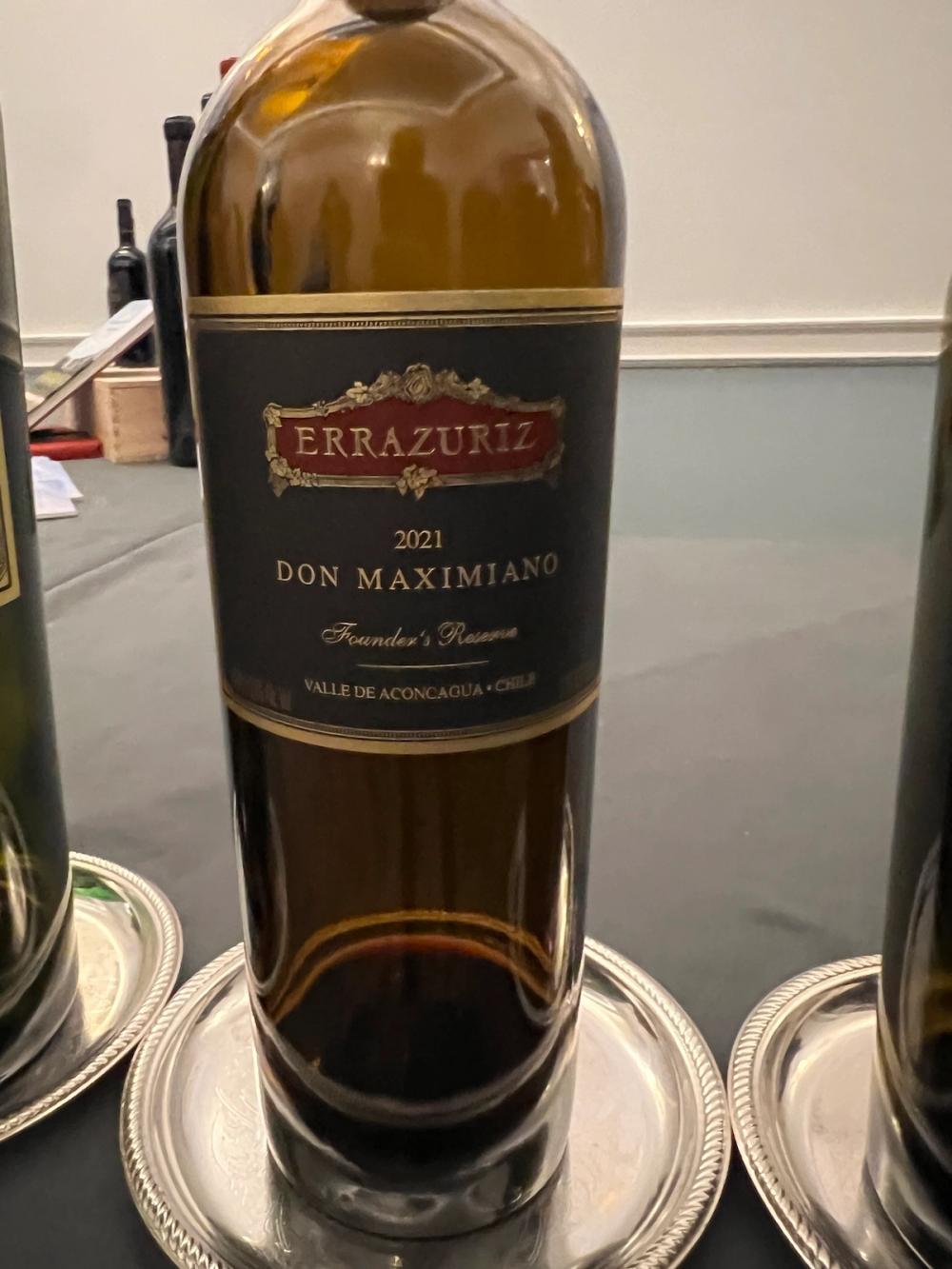
Don Maximiano Founder’s Reserve 2021, D.O. Aconcagua Valley
The changing assemblage – Cabernet Sauvignon 63%/ Malbec 22%/ Carmenere 8%/ Petit Verdot 7% – reflects the changed vineyard base, based upon a greater understanding of the soil. As a result Cabernet Sauvignon was planted more on gravel soils and the Carmenere and Malbec in heavier soils.
From a ‘perfect’ vintage for a more elegant style, the wine is intense, opaque purple, milk chocolate, vanilla, dried violets and herbs on the nose while the palate is ripe, juicy, with bags and bags of flavour, a touch of espresso on finish. Lovely harmony and the way the wine hangs together.
KAI 2010, D.O. Aconcagua Valley
Debuting in 2005 and named after the local language for ‘plant’, this is a showcase for Carmenere, Chile’s signature grape which was once called Chilean Merlot and is a tricky variety to grow – difficult to ripen and subject to disease.
Intense, ripe, fresh, juicy, very fruity with almost imperceptive, well-integrated tannins and structure without it being obviously structured. Coffee, chocolate notes, fresh red pepper, black fruit. Intense and layered.
KAI 2021, D.O. Aconcagua Valley
Although, like the Don Max, the oak is dialled down in the new vintage (60% new French oak as oppose to 100%) you do notice the wood more (weirdly), a reflection of its youth, perhaps. Deep red, complex with black fruit aromas and suggestions of pepper, nutmeg, figs. Youthful palate, fine, polished tannins, firm acidity, great texture. This is a wine with much more finesse than the 2010 but just needs time.
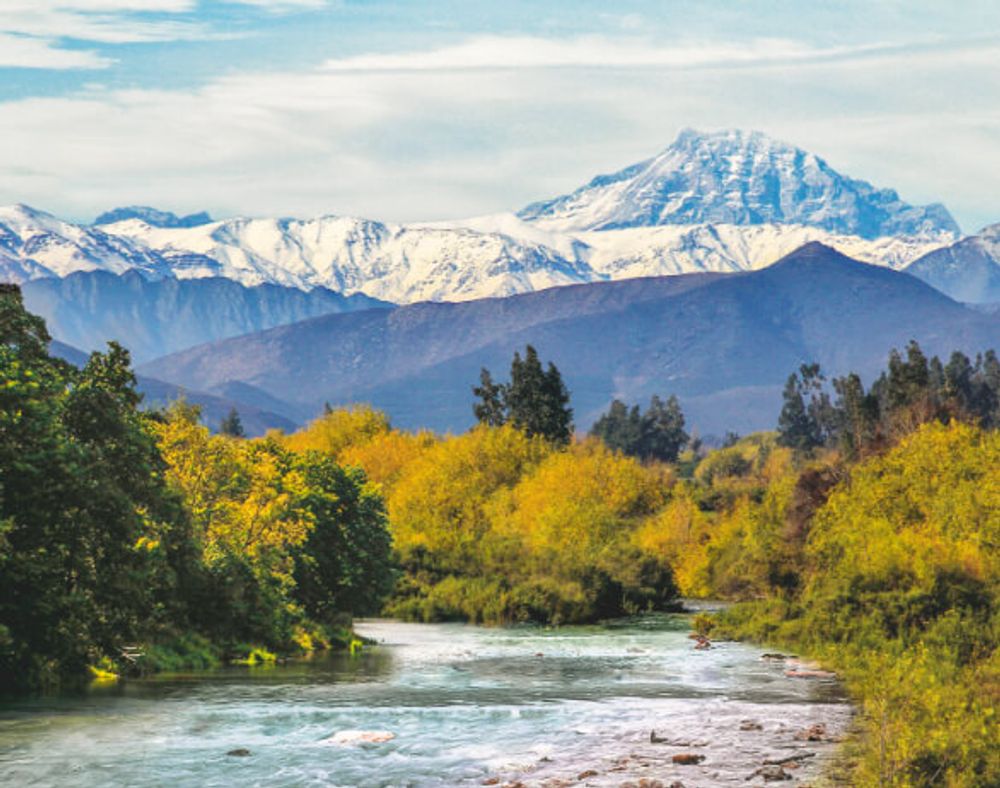
The Aconcagua valley, Chile
Seña 1998, Aconcagua Valley
A joint venture with Robert Mondavi who first travelled to Chile in 1991, two years after the first democratic elections; Mondavi had the vision to capture the identity of a country in much the same way that Opus One had done in Napa and have a wine from Chile be recognised amongst the world’s First Growths.
This was also a project that would blend Cabernet Sauvignon with Carmenere, the site being found after a four-year search and one that is just 40km from the cooling influence of the Pacific Ocean, the agriculture being biodynamic to better interpret the terroir. 90% Cabernet Sauvignon the rest made up of Carmenere and Merlot, 18 months in 92% new French oak.
Cassis and black cherry notes, touch of spice and burnt sugar. The mouthfeel is concentrated and very ripe, rounded, velvety tannins, sweet finish. The acidity is deceptive and cloaked by the abundance of fruit. Lovely aged Cabernet showing through with time in the glass.
Seña 2015, Aconcagua Valley
An absolute stonker of a wine and one that rightly got all the critics purring. It’s still got a way to go but it’s in such a good place. Intense, complex nose mixing red and black fruit, cherries to the fore. Filigree tannins, lovely depth of flavour, astonishing heart of the wine and balance – micro-fine texture, acidity, ripe fruit – incredible balance.
Much more layered, complex and elegant than the ’98 – partly because of the assemblage – 57% Cabernet Sauvignon, 21% Carmenere, 12% Malbec, 7% Petit Verdot and 3% Cabernet Franc – and the vinification which only has 65% new French oak and 12% of the wine in large foudres.

Seña 2021, Aconcagua Valley
Another change in the blend with Malbec turned up and Carmenere turned down and no Cabernet Franc.
Much younger than the 2015 with a green edge, the fruit more blue-black than red-black. Aromas have dried rose, strawberries and cloves, the palate is incredible! Blackcurrants, bitter chocolate with a lovely citrus edge. What is so remarkable is that even when young the tannins are not angular – there’s a velours texture here. Incredible winemaking.
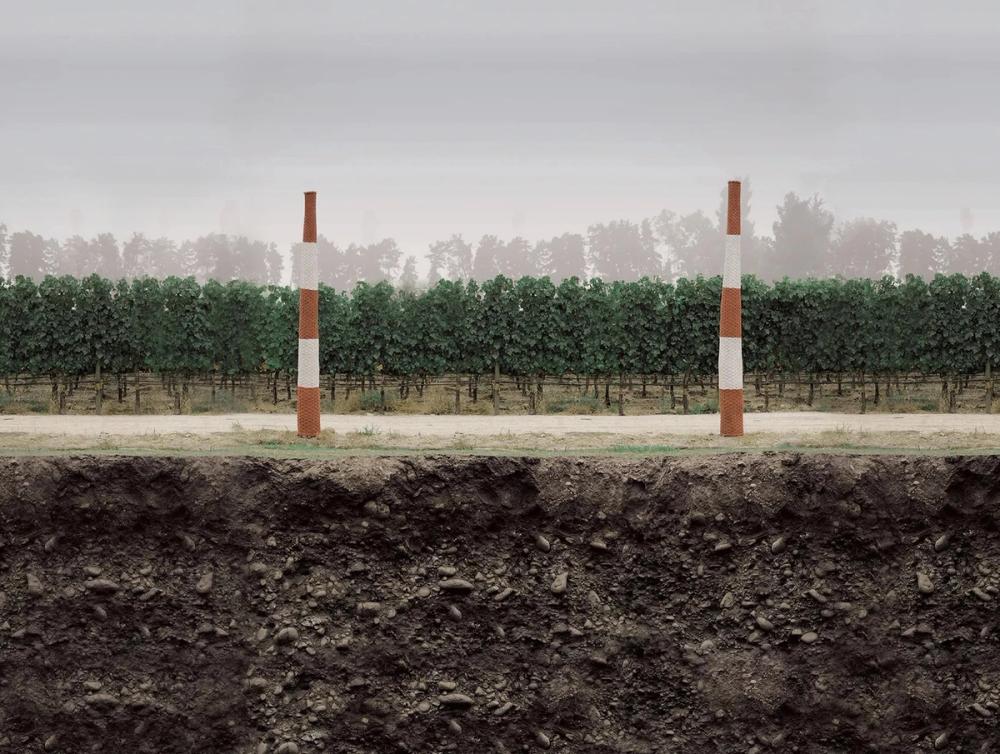
Ideal terroir for Cabernet: the goals from the polo field remain at the Viñedo Chadwick vineyard
Viñedo Chadwick 2000, Puente Alto D.O., Maipo Valley
It’s a brave man who plants vines into his father’s beloved polo field, especially when he was one of the greatest players in the country’s history, but that is what Eduardo did (with his father’s permission) and the result is a wine that will forever honour the memory of Alfonso Chadwick.
The 15 hectare plot is at the heart of Puente Alto D.O. which is the best spot for growing Cabernet Sauvignon not only in Chile but also one of the top sites in the world. A key factor is the calcium carbonate in the alluvial soils which helps the wine retain a striking freshness.
This 2000 vintage is the second iteration of a wine that not only changed the course of the winery but also the world’s perception of Chilean wine, Cabernet Sauvignon, in particular.
100% Cabernet Sauv, aged for 18 months in 100% new French oak. On the nose you just get Bordeaux. There’s morello cherry, cassis, black chocolate, leather, summer truffle. The palate is lush and giving, blackberries and cherries, crème de mûre. Superb balance. Unmistakably New World fruit IMHO.
Viñedo Chadwick 2014, Puente Alto D.O., Maipo Valley
Half the crop was lost to frost, the resulting wine spent longer in barrel but just 75% new. Wow! This is a game-changer. Fabulous freshness, terrific register on the palate, elegance. The nose is vivid and promises blueberries, Pomfret cake, cherries and then the palate delivers with a disarming balance between vibrant freshness and solid structure, deliciously just-ripe black fruit.
This is a more thoughtful/ contemplative wine than the 2000, elegant, beautiful – phenomenal pure and simple. Right up there with the very best wines I have tasted.
Viñedo Chadwick 2020, Puente Alto D.O., Maipo Valley
Viñedo Chadwick is a gift that keeps giving. Expressive, concentrated, complex. The nose has some attractive, savoury characteristics – balsamic, cocoa – that beguiles with red fruit. The palate is marked by incredible structure, gravelly texture, it is tannic, tense with a tightly wound core. Intense and persistent.
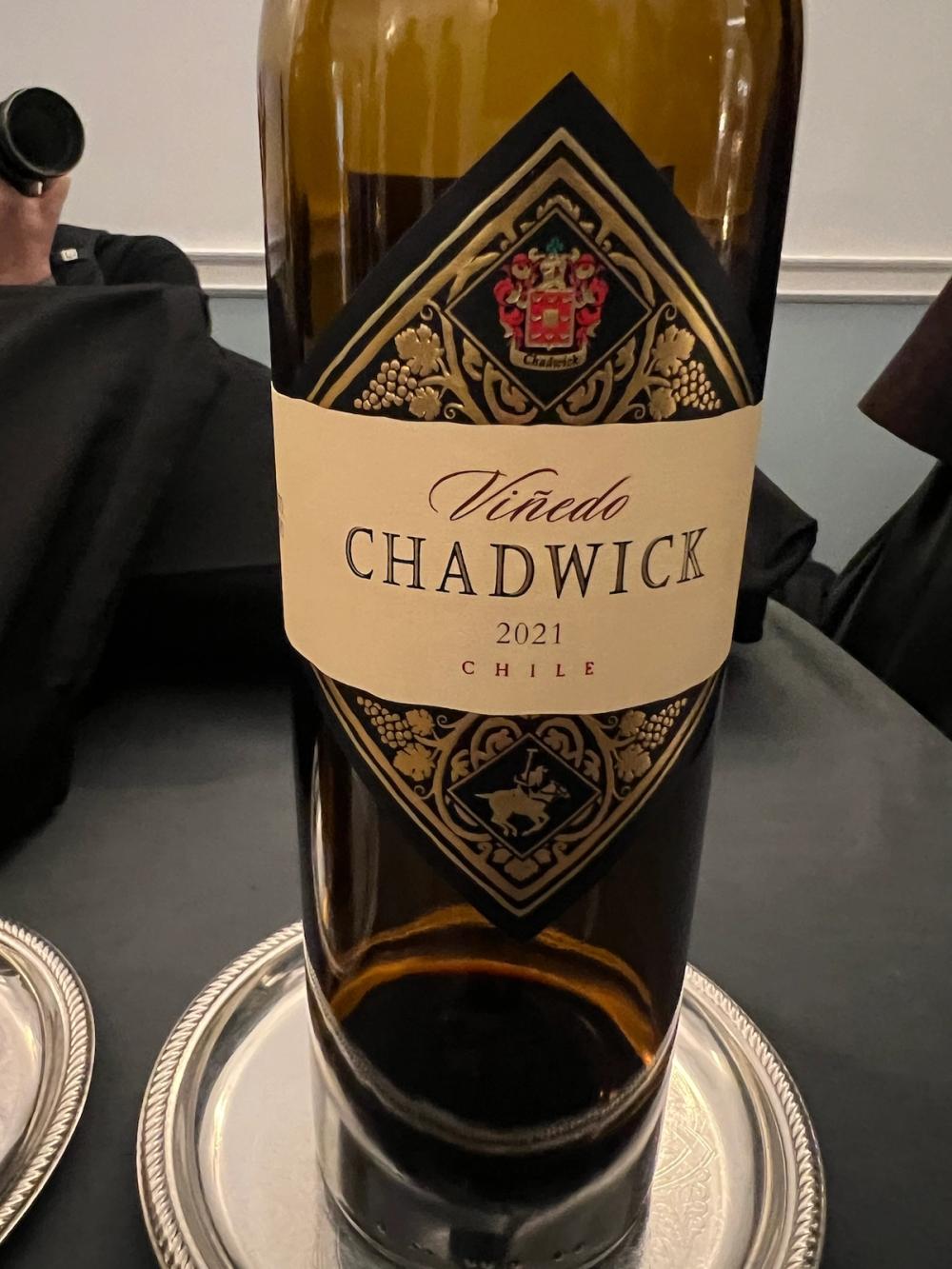
Viñedo Chadwick 2021, Puente Alto D.O., Maipo Valley
A cool year, with a long ripening season has done wonders for the wine after the dry warmth of 2020. It has 3% of Petit Verdot added, 20% aged in foudres.
The wine comes across like a First Growth Bordeaux – sleek, precise, tense with floral, mocha, graphite notes, a touch of greenness; on the palate the wine has youth, finesse and elegance, freshness, layers, chocolate and sweet spice playing around with the cassis, the tannins have a bit of a chew but this is pretty much perfect with everything right and in its right place. Refined, stylish and serious.
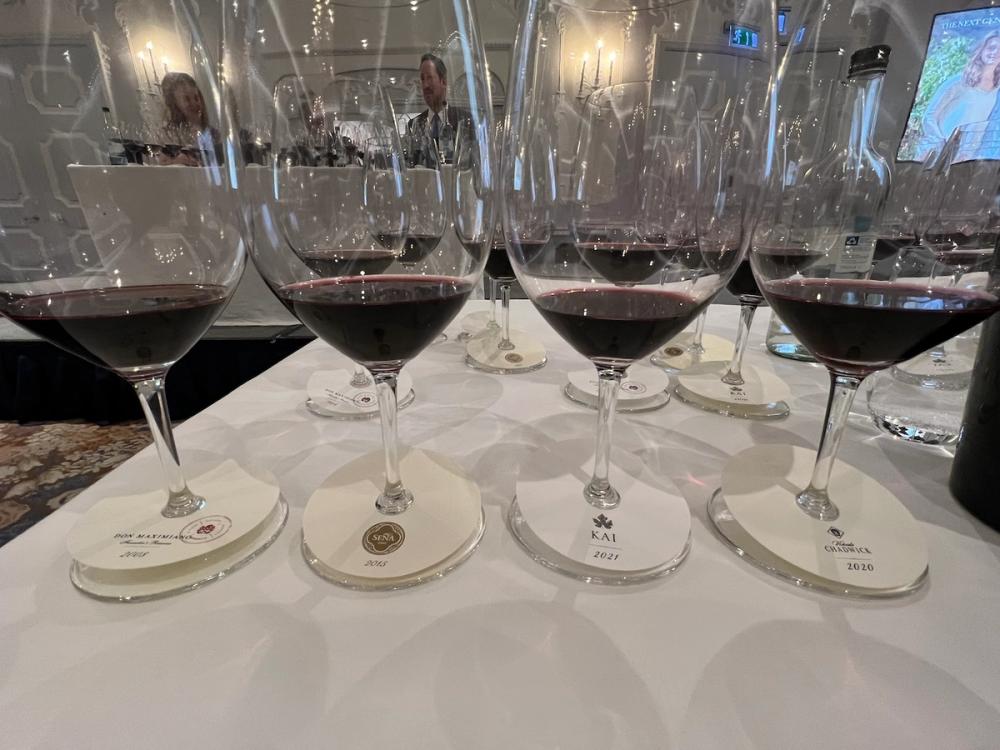
My favourites on the day
A stupendous tasting then with much to enjoy. If I had to pick my favourites from each of the four wines they would be Don Max 2008, Kai 2021, Sena 2015 and VC 2014, 2020 or 2021 – hard to choose!
‘Judgments’ future
The 'Five Decades' retrospective in London was the second date on a worldwide tour that began in Berlin (naturally) in February and then moves to Brazil in April, the Far East in May, and so on, winding up in Santiago at the end of November.
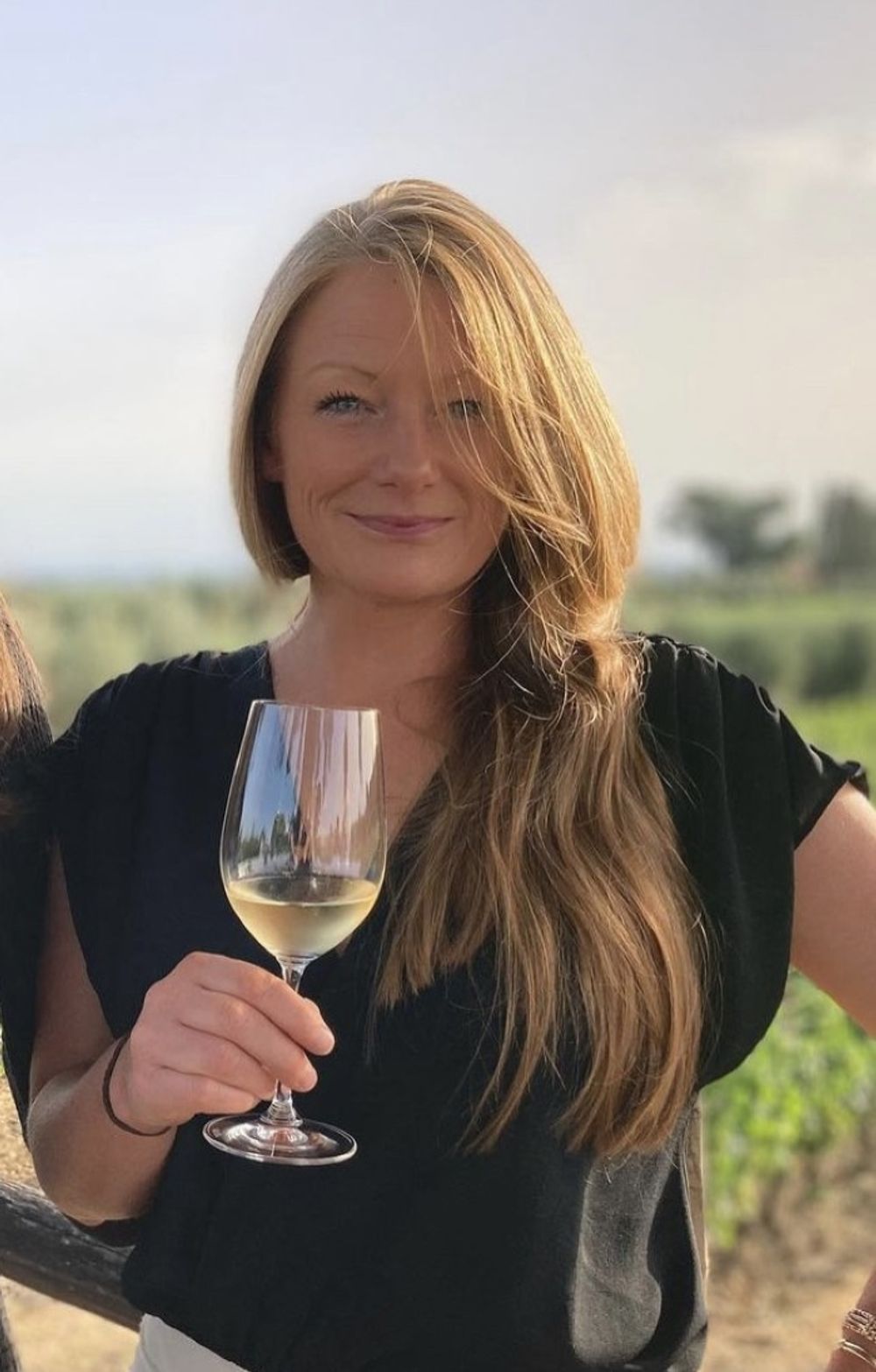
Georgie Crawley
As for developing the brand and the exposure of the premium wines in the UK, Hatch Mansfield has just announced the appointment of Georgie Crawley as UK director of Chadwick Family Estates, responsible for the four wines that were the focus of the retrospective as well as Le Cumbre and Las Pizarras.
This is a further sign that Eduardo and family are not ones to sit on their laurels but will continue to build, until the whole wine world recognises these wines for what they truly are – able to compete and rub shoulders with the world’s most renowned estates.
The wines of Chadwick Family Estates are imported and sold in the UK through Hatch Mansfield which is a commercial partner of The Buyer. To discover more about them click here.
